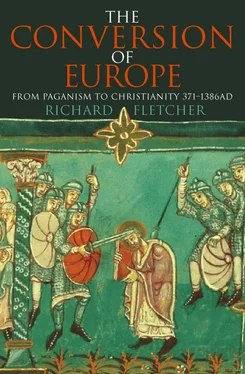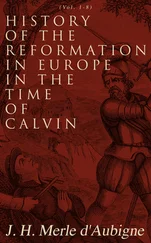The main reason why we know so little of Ulfila lies in the victory, never to be reversed, of Nicene orthodoxy in official circles in his last years. It is a good example of the adage that history is written by the victors. The memory of Arius and his followers was systematically vilified, their writings hunted down and destroyed. Ulfila was too big to be ignored; but he could be, and was, belittled. Had the moderateArian creed to which he adhered come out on top, Ulfila would be remembered as one of the giants of the fourth-century church. As it is, we have to struggle with fragmentary and ambiguous texts to discern even the shadowy outline of a notable career.
What then was the significance of Ulfila? He was not a missionary in the generally accepted sense of the word. He did not go off to live among a heathen people in order to convert them to Christianity. Instead, he went as the bishop of an existing Christian community beyond the imperial frontier, a community which no doubt included persons of Gothic birth but which was principally composed of displaced foreigners living under Gothic rule. We need not doubt that this community made converts among the Goths in Ulfila’s day as it had done before; but conversion of the heathen was not perceived as its prime function. The Christians in Gothia were, in Gibbon’s words, ‘involuntary missionaries’. 2
Ulfila was almost certainly not the first churchman to have been sent to serve Christian communities among the Goths beyond the imperial frontiers. Among the bishops who attended the council of Nicaea in 325 was a certain Theophilus ‘of Gothia’; it has been conjectured that he ministered to Christian communities among the Goths settled in the Crimea. A letter of St Basil of Cappadocia written in about 375 refers to a certain Eutyches, who had evidently lived at some time past but of whom nothing further is known, in terms which suggest ministry in Gothic lands. However, as we have already seen in the course of discussion in Chapter 1, there was at that period no sense that it was the duty of the Romano-Christian world to evangelize pagan barbarians beyond its borders. Christianity was not for outsiders. So we are told: yet the question may be probed a little further. The adhesion of Constantine to Christianity was followed by an ever more strident and assertive trend towards the near-identification of empire and church. Christianity thus became a part of the empire’s cultural armoury. Did it occur to the imperial establishment of the fourth century, as it would in later centuries, that the faith could be used to tame threatening barbarians in their homelands? We do not know, but it looks as though the Goths thought so. Each of the two known outbreaks of anti-Christian persecution by the Gothic authorities in the fourth century coincided with periods of military hostilities between Goth and Roman. The first of these was in 347–8, when Ulfila left Gothia to cross the Danube and settle at Nicopolis. The second came in the wake of Valens’ Gothic war of 367–9. We are rather well informed about it owing to the survival of an account of the sufferings of a Gothic martyr, Saba, who perished on 12 April 372. A recent authority has commented that ‘the Goths would seem to have been afraid that Christianity would undermine that part of Gothic identity which was founded in their common inherited beliefs, so that religion was not just an individual spiritual concern, but also a political issue standing in some relation to GothoRoman affairs.’ 3
All of which prompts further speculation about the role of Ulfila. His relations with the imperial Christian establishment were close: he was consecrated a bishop in Constantinople, given land near Nicopolis by his admirer Constantius, attended councils within the empire, was apparently confident of his intercessory powers with Theodosius I. It is impossible not to reflect that when he returned to the empire in 347–8 Ulfila must have been in a position to furnish the government with a good deal of useful intelligence concerning goings-on in Gothia: possibly on other occasions too. Does this mean that in going to Gothia as a bishop Ulfila was undertaking what has been called an ‘imperially-sponsored mission’? That is perhaps to go too far. Ulfila was not a Roman agent. We must remember that he was so far trusted by the Gothic authorities as to be commissioned to negotiate on their behalf on two occasions that we know of, possibly on others of which we are ignorant. Ulfila faced both ways. Missionary or quasi-missionary churchmen often do.
It is entirely appropriate, in the light of this, that his most enduring achievement should have been the translation of the Bible into Gothic, giving to his people, or his people by adoption, the holy writings of the Roman faith in their own Germanic tongue. Here is Philostorgius again: ‘He was the inventor for them of their own letters, and translated all the Scriptures into their language – with the exception, that is, of the books of Kings. This was because these books contain the history of wars, while the Gothic people, being lovers of war, were in need of something to restrain their passion for fighting rather than to incite them to it.’ Ulfila was not the first to undertake biblical translation; the so-called ‘Old Latin’ and Syriac versions were already in circulation. But these were existing literary languages current within the Roman empire. To no one had the notion occurred of translating the scriptures into a barbarian tongue which had never been written down before. Perhaps, as is often the case with simple but revolutionary and liberating ideas, it could only have come to one who was himself in some sense an outsider.
4. To illustrate the activities of Ninian and Patrick in the fifth century.
If we now direct our attention to the western extremities of the empire at a time a couple of generations or so after Ulfila’s day we shall meet two further instances of the same phenomenon, the sending of bishops to existing Christian communities outside the imperial frontier. We shall also encounter something altogether unexpected in a late-antique context: a churchman who experienced a missionary vocation to take the faith to heathen barbarians and who has left a precious account of how he came to engage himself in such an eccentric activity.
Our first instance is a very shadowy one, about whom we know far less than we do about Ulfila. Ninian, or Nynia, was the name of a British bishop sent to minister to a community of Christians in what is now Galloway in the south-west of Scotland. His episcopate is most probably to be placed somewhere in the middle years of the fifth century. By this time the Roman provinces of Britain were no longer part of the empire. As with Dacia in the 270s, so in 410 the government of the Emperor Honorius had taken the decision to withdraw the apparatus of Roman rule from Britain. It is unlikely that contemporaries imagined that this state of affairs would be permanent; both the imperial government and the British provincials probably anticipated that at some stage in the future, when times were easier, Roman control would be reimposed. Meanwhile, life in Britain seems to have gone on in much the same way until well into the fifth century.
Galloway was within reach, by way of the easily navigable Solway Firth, of the contiguous parts of what had been Roman Britain: the town of Lugubalium (Carlisle), the forts of the Cumbrian coast, and the farms of the Eden valley. A scatter of small finds – coins, pottery – of Romano-British material in south-western Scotland indicates that connections were established. How a Christian community grew up there we have no means of knowing, but that one was in existence by the fifth century is certain. It is attested by the so-called ‘Latinus’ stone at Whithorn, datable to c. 450, whose enigmatic Latin inscription may record – the latest suggestion by a leading authority – the foundation of a Christian church there by a man named Latinus. 4 We have a context for Bishop Ninian. We might also have the names of two of his successors. Some twenty miles west of Whithorn, at Kirkmadrine in the Rhinns of Galloway, another inscribed stone, possibly of the early sixth century, commemorates ‘the holy and outstanding sacerdotes Viventius and Mavorius’. ( Sacerdotes could mean either ‘priests’ or ‘bishops’: in the Latin of that period the second meaning was more common than the first.)
Читать дальше












